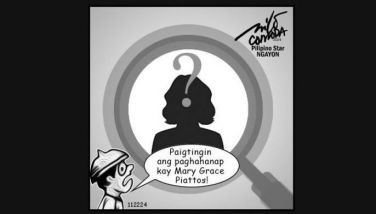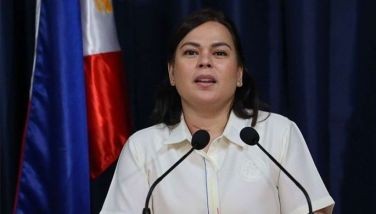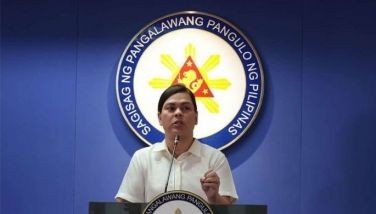Add air pollution index to daily weather report

ON MOST days, one can view from a vantage in the hills of Antipolo a dark brown shroud of deadly air hanging over the nation’s capital. Only when a typhoon blows through Metro Manila is the noxious blanket of pollution lifted – but only for a day after the storm.
Air pollution in this traffic-choked, heavily populated region is an old horror story, one would think the government would have acted by now to abate the problem. It has not.
Since officials live, travel and work in air-conditioned comfort, the government is not acting – as far as we know – to minimize the health hazard threatening the 20 million residents of the capital region and the contiguous provinces of Bulacan and Southern Tagalog.
The government is probably waiting to see people collapsing, gasping for air, on EDSA and other busy thoroughfares where noxious air particulate levels have risen to alarming levels.
The Department of Environment and Natural Resources with the assistance of a few local governments have put up air quality monitoring facilities. But what can the disparate data collected, assuming the devices work, do by themselves in improving the quality of the air we breathe?
To help elevate public consciousness and prod action on the problem, we propose that the daily weather bulletins always include an integrated report on the quality of the air in the national capital, and all urban centers throughout the country.
Filipinos read, with envy, the daily Pollutant Standards Index (PSI) reports in nearby Singapore on its air quality, now deteriorated by the haze wafted by winds from forest fires set by slash-and-burn farmers in Indonesia’s Sumatra.
Singapore’s PSI monitoring integrates by-the-hour measurements of six air pollutants: sulphur dioxide (SO2), particulate matter (PM10), fine particulate matter (PM2.5), nitrogen dioxide (NO2), carbon monoxide (CO) and ozone (O3). The PM2.5 is newly added.
Other countries call their PSI something else, but the general idea is the same. In da Pilipins, we do not call it anything yet, because we still do not have it. In fact, the particulate matter spewed by EDSA smoke-belchers, abetted by wind-blown dust, is not even measured.
Is it too much to ask the DENR and the Department of Science and Technology to add an air quality index to the daily weather report? Or do we wait for the next Roxas-Robredo administration to act on this?
• People can’t rule on constitutional issue
BEFORE propaganda sinks in that all that is required of a would-be president is a pure heart welling with good intentions, let us be reminded that there is no escaping the BASIC qualifications set by the Constitution.
It is pointless to advertise the patriotism, integrity, competence and good faith of a presidential aspirant unless he first satisfies the basic qualifications required by the Constitution in Section 2 of Article VII, to wit:
“No person may be elected President unless he is a (a) natural-born citizen of the Philippines, a (b) registered voter, (c) able to read and write, (d) at least 40 years of age on the day of the election, and a (e) resident of the Philippines for at least 10 years immediately preceding such election.” (Bold face supplied)
If the aspirant lacks at least one of these five first-level qualifications – such as being a natural-born Filipino – he cannot legally be allowed to run for the top elective post in the land even if he possesses angelic or superhuman qualities that would make him an ideal leader.
We are forced to call attention to this basic fact, because of a vox populi theory being spread by supposedly knowledgeable and responsible quarters that the resolving of a challenge to a candidate’s qualifications can be taken away from the court and tossed directly to the people.
Bypassing the Constitution is a most dangerous, if desperate, proposition.
The citizenship and residency challenge to independent presidential candidate Sen. Grace Poe Llamanzares is a case in point.
Whether or not the senator, whose parents are still unknown, is a natural-born Filipino involves the constitutional question of qualification. Resolution of this issue cannot be tossed to the second-level screening by the electorate, as some expensive lawyers and propagandists insist.
• Mayor’s wife in Aman scam running in 2016
REMEMBER the investment scam involving the Aman Futures Group that duped about 15,000 investors from the Visayas and Mindanao of some P12 billion in 2012?
Just recently, the Manila Regional Trial Court Branch 14 denied former Pagadian City Mayor Samuel Co’s motion to be granted bail over charges of syndicated estafa for his alleged involvement in the Aman Futures scam.
That was welcome news to the victims of the investment firm. The bad news to them, however, was that his co-accused wife Priscilla Co was granted bail.
The ex-mayor admitted handing out checks, but denied being a member of the investment firm. Co issued business permits to Aman Futures Group owner Manuel Amalilio and to Fretz and Sha Trading owned by Aman Futures operator Fernando Luna.
Last May, one of the 13,000 complainants, Fabian Tapaya Jr., asked the court to junk Samuel Co’s motion for reconsideration and leave of court to admit additional evidence. The Manila RTC did not grant bail to the ex-mayor.
Now the twist, to the consternation of the scam victims, is that Co’s wife Priscilla still has the face to run for Pagadian mayor in 2016 while out on bail. His detractors will have to live with the fact that she has not been convicted and is still presumed innocent.
* * *
RESEARCH: Access past POSTSCRIPTs at www.manilamail.com. Follow us via Twitter.com/@FDPascual. Email feedback to [email protected]
- Latest
- Trending





























